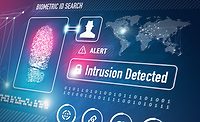How New Solutions and Convergence Reduce Fraud in the Banking Environment

Financial organizations across the world face a new risk paradigm: one that encompasses cyber and physical threats, such as ATM skimming, identity theft, data breaches, scams and phishing. Large financial services organizations are often the victim of hackers looking to steal corporate information and transactional data or funds, and criminals continue to become more sophisticated in their approach.
Facial recognition, biometrics, deep learning, the Internet of Things (IoT), artificial intelligence and robotics – These are just some of the many trends and themes today’s financial institutions are evaluating as part of the growing idea of the “connected world.” But how do we best use them moving forward and what are the overarching benefits? Here we take a look at the top solutions that will drive new capabilities for the banking world in 2018.
Big Data Analysis
To maintain a high level of security and ensure business continuity around the globe, banks seek solutions that help predict and identify threats in real time. But often, there are too many alerts generated by too many systems, and none of this raw data is actionable. Linking cyber and physical security together transforms alerts into actionable intelligence, which helps users connect the pieces of any situation and present a unified risk scenario to the appropriate analysts and operators. By capturing and analyzing data in real time, financial organizations gain a visual representation of risks across the business while accessing information related to the most critical events happening at any given time. Not only does this unified process enable a higher and more proactive level of protection, but it also helps facilitate a plan of action based within a common, unified security operations center.
The fusion of technology and internal leadership creates a surplus of information, and users seek to gain more insights from this combined data to enhance security and business operations alike. There are significant benefits to leveraging video and security data for marketing, customer engagement and branch safety, but this is just the tip of the iceberg. New use cases are being rolled out on a daily basis as users find innovative ways to leverage the intelligence gleaned from this data.
The bottom line is that the use of big data analysis increases situational awareness and enhances security, enabling improved information sharing and faster, more effective response.
Deep Learning
Analytics and Deep Learning help organizations make sense of vast amounts of information for more effective decisions, and immediate action and response. But what does that really mean? Integrated analytic applications can automatically pinpoint potential breaches and significant events and send video alerts to the appropriate personnel, departments, and agencies. They are ideal for the banking environment; they can minimize false alarms and keep a watchful eye over a bank’s branch and ATM network regardless of whether or not there is a 24/7 security command center. All of this results in:
- Enhanced situational awareness and transformed threat detection
- Advanced insight into security risks
- Automatic calibration improves accuracy and reduces operating costs
- Advanced integrated analytic detection rules
So what are the “cool” new analytics in today’s market? Advanced solutions leverage artificial intelligence to identify the most relevant data to enhance a bank’s monitoring, reporting, and response capabilities. These analytics literally track an individual by utilizing a series of various camera views. This tracking ability empowers the user to focus on the most critical data points instead of manually locating a suspect’s whereabouts within an organization. How cool is that?
Of course, the biggest value analytics provides is that it helps manage and segment all your organization’s captured data. With all of the information accessible today, it has become vital for organizations to invest in analytics. Without robust analytics, all of these data points are just noise and can become cumbersome to the security professionals who must make sense of it for it to be useful.
It’s All About the IoT
The IoT revolves around increased machine-to-machine communication; it's built on cloud computing and networks of data-gathering sensors and is mobile, virtual, and instantaneous — all characteristics today’s businesses and business leaders look to incorporate daily to further streamline operations and efficiency. The IoT is projected to grow at a rapid rate, making various devices from streetlights to grids “smart.” Gartner forecasted that 6.4 billion connected items would be in use worldwide in 2016, up 30 percent from 2015, and will reach 20.8 billion by 2020.
Mobile capabilities increase convenience, but with this connectivity comes an expanded risk for threats and breaches. Security is no longer limited to just physical assets; electronic and cyber elements must also be considered to ensure comprehensive coverage throughout an organization's infrastructure. It’s a fact: cyber threats have taken a front seat in the lineup of primary risks facing financial institutions today. According to Cybersecurity Ventures, the amount of money taken in cyber heists, both in banking and elsewhere, was estimated at $3 trillion overall for 2015, and this substantial amount is expected to double by 2021.
In today’s environment, banks, credit unions, and financial organizations of all types are primary targets for hackers. But it’s not just the monetary loss that these businesses need to be concerned about — there is also a threat to the brand, customer trust and employee safety.
The bottom line is that as the need for connectivity increases, so too does the need for increased security for physical assets, networks and valuable corporate data. As a result, a dialogue between IT and physical security is necessary to help leaders gain a greater knowledge of how to best collaborate to ensure complete protection. Leaders must communicate closely to drive strategies that help identify vulnerabilities in a more proactive manner. The result of these conversations is a truly comprehensive approach to security intelligence.
Into the New Year
Technology is a great force multiplier. Security — both cyber and physical solutions — helps secure an entire branch footprint, alleviates risk, ensures operational compliance, and improves fraud investigations. As we get closer to 2018, we will continue to see Big Data analysis, video analytics and IoT-powered devices allow for the collection of myriad data points across systems, services, and devices. Banks will be able to investigate threats in a more intelligent manner and generate actionable intelligence from collected data points to achieve their strategic intelligence and business objectives in the coming years.
Looking for a reprint of this article?
From high-res PDFs to custom plaques, order your copy today!






